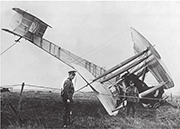E-Archive
Off the Beaten Track
in Vol. 20 - September Issue - Year 2019
In a Peat Bog

In a peat bog

Brown and Alcock having lunch before their record flight
June 2019 marked the one-hundredth anniversary of the first nonstop transatlantic flight. On the afternoon of June 14th 1919, British aviators John Alcock and Arthur Brown took off from St. John’s in Newfoundland, Canada and landed near Clifden, Ireland approximately sixteen hours later. Theirs was a harrowing flight. Twice they came within a few meters of crashing into the sea, while fog, snow, rainstorms, freezing temperatures and mechanical problems plagued them from the start. The story of how they overcame these difficulties to complete their journey is remarkable.
****
Interest in aviation grew rapidly at the beginning of the twentieth century. The First World War accelerated this process, as countries on both shores of the Atlantic came to realize the enormous potential of military aircraft. A few days after the war had ended, the Royal Aero Club of the United Kingdom published the rules for an aviation competition. The owner of the Daily Mail newspaper offered a prize of £10,000 “to the aviator who shall first cross the Atlantic in an aeroplane in flight from any point in the United States, Canada, or Newfoundland to any point in Great Britain or Ireland, in 72 consecutive hours.” Three U.S. Navy flying boats had been the first aircraft to cross the Atlantic in May 1919, but the entire trip took twenty-four days, including a stopover in the Azore Islands, and consequently they did not qualify for the newspaper prize. Seventeen teams expressed interest in the Daily Mail competition, but a series of mechanical failures and cancellations greatly reduced their number. Although the rules of the competition allowed the flight to be made either way across the Atlantic, all of the teams chose to fly from west to east to take advantage of the favorable winds. This meant that the airplanes had to be designed, built and tested in the U.K., disassembled and shipped to America, where they would have to be reassembled and retested. One by one, the teams converged on St. John’s in Newfoundland, Canada, the closest point in America to the British Isles.
Being the first to arrive in March 1919, the Sopwith Aviation Company was able to pick the best spot to use as an assembly and takeoff point. During the war, Sopwith produced over 18,000 military aircraft used by British, French, Belgian and American air forces, including the famous Sopwith Camel. Their entry, a single-engine biplane called the Sopwith Atlantic, had a jettisonable undercarriage to reduce drag and a section of the fuselage that could be used as a boat in case of an emergency ditching at sea. This latter feature saved the lives of the pilot and navigator when they crashed into the sea and were rescued by a passing cargo ship.
The second team to take off was from the Martinsyde Company, whose entry was a single-engine biplane called the Raymor, a contraction of the crew’s names Raynham and Morgan. Their flight ended before it had even started when their undercarriage collapsed during takeoff due to the heavy load of fuel and the rough terrain.
Handley-Page appeared to be the favorites to win, with their considerable financial backing and the huge four-engined biplane based on their V/1500 heavy bomber. However the sheer size and greater complexity of their aircraft delayed their departure and forced them to watch in dismay as their competitor’s Sopwith Atlantic took off while they were still working on their aircraft on the ground.
The Vickers Company was the last to arrive at St. John’s. They came with a modified Vickers Vimy, a twin-engined biplane originally designed as a bomber for World War I. The two Rolls-Royce Eagle Mark VIII engines with four-bladed propellers delivered 360 HP. The aircraft was 13 meters long and almost 5 meters high, with a wingspan of about 21 meters. Its empty weight was a little over 3 metric tons. It carried almost 4,000 liters of fuel and about 230 liters of motor oil at a cruising speed of 145 km/h. The plane had an open cockpit with two side-by-side seats. A similar version of this plane, but fitted with two cockpits to seat the four crew members, was used five months later in the successful attempt to fly from Great Britain to Australia within thirty days.*
Alcock and Brown landed nose-down in a peat bog near Clifden, County Galway, on June 15th 1919. They were met by huge crowds and celebrated as heroes wherever they went and were knighted by King George V a few days later.
*see Off the Beaten Track, November 2006
By Giovanni Gregorat, Contributing Editor MFN



























